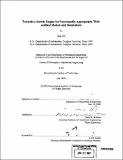Towards a search engine for functionally appropriate, Web-enabled models and simulations
Author(s)
Cao, Qing, Ph. D. Massachusetts Institute of Technology
DownloadFull printable version (35.02Mb)
Other Contributors
Massachusetts Institute of Technology. Dept. of Mechanical Engineering.
Advisor
David R. Wallace.
Terms of use
Metadata
Show full item recordAbstract
New emerging modeling and simulation environments have the potential to provide easy access to design models and simulations on the Internet, much as the World Wide Web (WWW) has provided easy access to information. To support sharing, integration and reuse of web-enabled applications (design models and simulations), a search engine for functionally appropriate/similar models is needed. There are ongoing efforts to develop ontological descriptions for web content and simulation model functionality, where semantics of available services are explicitly represented using a shared knowledge representation of concepts and rules. Simulation publishers are responsible of semantically marking up the interfaces with such ontological annotations. In contrast to such an approach, this work proposes a flexible, implicit, pattern matching solution that does not require any extra annotations to accompany, the models, much as the way current web search engines operate. A learning-through-association, similarity-based approach was developed. It uses only pre-existing low-level information in web-enabled simulation interfaces-such as model and parameters names, parameter units, parameter scale, input/output structure, causality, and documentation - to synthesize templates that become archetypes for functional concepts. (cont.) Then, different interfaces are matched against templates and are classified based on how they are similar to a certain template. Newly found functionally similar interfaces can be merged into the original template, thereby both generalizing the pattern for a functional role and strengthening the most critical aspects of the pattern. This thesis also developed algorithms based on graph theory and pre-defined heuristic attributes similarity metrics. The information from model interfaces is represented using Attributed Relational Graphs (ARG), where nodes represent parameters and arcs represent causality relationships. Templates are represented as Fuzzy Attributed Relational Graphs, which are extended ARGs whose node attributes are fuzzy sets. Then, a bipartite graph-matching algorithm is used to compare graphs and the similarity between an interface and a template. Graph merging algorithm is also designed for template generalization. A prototype implementation of proposed algorithms is developed and applied to a suite of real-life engineering models. Results validate the hypothesis and demonstrated the plausibility of the approach.
Description
Thesis (Ph. D.)--Massachusetts Institute of Technology, Dept. of Mechanical Engineering, 2006. Includes bibliographical references (p. 100-104).
Date issued
2006Department
Massachusetts Institute of Technology. Department of Mechanical EngineeringPublisher
Massachusetts Institute of Technology
Keywords
Mechanical Engineering.